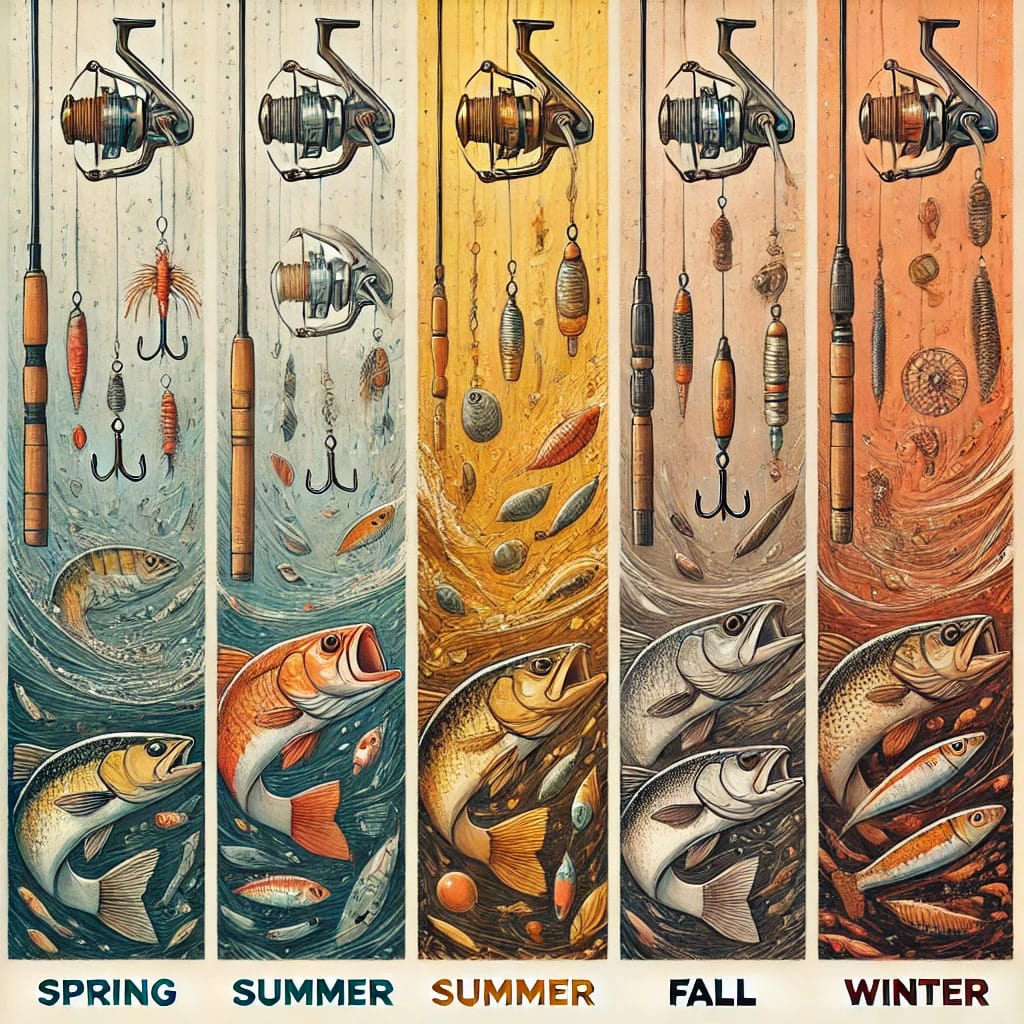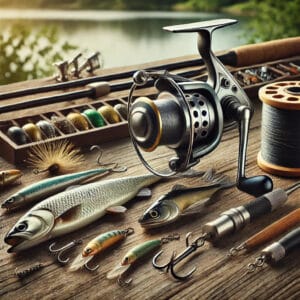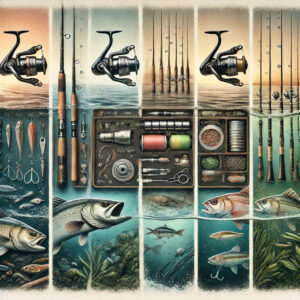Fishing is a rewarding outdoor activity that requires the right tools to be successful. One of the most important factors in determining your success is selecting the correct fishing tackle based on the water conditions. Whether you’re fishing in freshwater, saltwater, still waters, or fast-moving rivers, understanding how different water environments impact your choice of tackle can make all the difference.
As an experienced angler, I’ve learned that adapting my gear to water conditions is crucial, and I’ll walk you through how to make the best selections for different environments.
Understanding Water Conditions and Their Impact on Fishing Tackle
Before diving into the specifics of choosing fishing tackle, it’s essential to understand how various water conditions affect fishing. Fish behavior, water clarity, temperature, and current all influence your tackle choice, from the type of rod and reel to the lures and bait you’ll use. Here’s a breakdown of how water conditions can impact your tackle selection:
- Water clarity: Clear water allows fish to see more clearly, requiring more realistic and subtle tackle, while murky water calls for brighter, more noticeable gear.
- Water temperature: Fish are more active in warmer water and tend to be sluggish in cold water, which affects the size and type of bait to use.
- Water movement: Fast-moving waters may require heavier tackle to keep your bait in place, while calm waters can handle lighter gear.
1. Fishing in Clear Water
In clear water, visibility is high, meaning fish can easily spot your tackle and bait. To avoid spooking fish, it’s important to use a subtle and natural-looking approach.
Recommended Tackle for Clear Water:
- Line: Opt for a lighter, more transparent fishing line like fluorocarbon, which is less visible underwater.
- Lures: Natural colors work best in clear water. Go for realistic baitfish or crayfish imitations in colors like brown, green, and silver.
- Rod: A lightweight rod with fast action is ideal for finesse fishing in clear water, as it provides greater sensitivity.
- Bait: Live bait like worms or minnows are also great choices since they look more natural in the water.
2. Fishing in Murky or Stained Water
Murky or stained water limits visibility, meaning fish rely more on sound and vibrations than sight. This gives you more freedom to use bright and bold tackle to attract their attention.
Recommended Tackle for Murky Water:
- Line: In low visibility conditions, a heavier line like monofilament can be used since fish won’t notice it as easily.
- Lures: Brightly colored lures in shades of chartreuse, orange, or yellow are effective in murky water. Additionally, lures that create noise or vibrations, like crankbaits or spinnerbaits, help fish locate the bait.
- Rod: A medium to heavy action rod works best for handling larger fish that may be more active in these conditions.
- Bait: Scented bait or soft plastics with added scent can be highly effective in stained waters, as fish rely more on their sense of smell to locate food.
3. Fishing in Fast-Moving Water
Fast-moving water, such as rivers or streams, presents unique challenges. Your tackle needs to withstand the current, keep your bait stable, and still be attractive to fish that are often hiding in eddies or behind rocks.
Recommended Tackle for Fast-Moving Water:
- Line: A heavier line is often needed to withstand the strong current, particularly braided line, which offers high strength without added thickness.
- Lures: Weighted lures like jigs, spoons, or heavy crankbaits are ideal, as they can sink quickly and stay in the strike zone even in fast currents.
- Rod: A heavy-duty rod with fast action allows for better control when fighting fish in strong currents.
- Bait: Using heavier sinkers with live bait can help keep your presentation steady in swift water.
4. Fishing in Still or Slow-Moving Water
Still water, such as lakes or ponds, gives you the flexibility to use lighter tackle since there’s no current to deal with. In these conditions, fish are often more spread out, and the key is to use tackle that mimics natural prey movements.
Recommended Tackle for Still Water:
- Line: A light line, such as fluorocarbon or monofilament, is ideal for subtle presentations in calm water.
- Lures: Soft plastics like worms, grubs, or topwater lures work well in still water where fish are more likely to see your bait slowly moving.
- Rod: A medium-light rod with moderate action is perfect for making precise casts in still water conditions.
- Bait: Live bait such as nightcrawlers or leeches work great in calm waters where fish are more relaxed and willing to investigate.
5. Fishing in Saltwater Conditions
Saltwater fishing introduces additional elements like salinity, larger species, and stronger winds and tides. Your tackle needs to be robust enough to handle these harsher conditions.
Recommended Tackle for Saltwater:
- Line: A strong, corrosion-resistant braided or monofilament line is necessary for saltwater fishing due to the presence of larger fish and rougher conditions.
- Lures: Saltwater lures are often heavier and more durable, with bright colors like blue, pink, or silver to mimic saltwater prey. Poppers and spoons work well in many saltwater scenarios.
- Rod: A heavy-duty rod with fast action is a must for handling powerful saltwater species like tuna, tarpon, or redfish.
- Bait: Live bait such as shrimp, mullet, or squid is commonly used in saltwater, as it mimics the natural prey fish are accustomed to.
6. Fishing in Brackish Water
Brackish water, found where freshwater and saltwater meet, presents its own set of challenges. Species like redfish and snook thrive in these waters, and your tackle needs to be adaptable.
Recommended Tackle for Brackish Water:
- Line: A medium-weight monofilament line works well in brackish waters, where both freshwater and saltwater species may be present.
- Lures: Use lures that can work in both environments, such as spoons, swimbaits, or soft plastics in natural colors.
- Rod: A medium-action rod with moderate sensitivity allows you to feel subtle bites and handle both freshwater and saltwater species.
- Bait: Shrimp and small crabs make excellent bait in brackish waters, as they are common prey for the fish species found in these areas.
Adapting Tackle to Seasonal Water Changes
Water conditions change with the seasons, and it’s important to adjust your tackle accordingly.

Here’s how to adapt your tackle setup for different seasonal water conditions:
- Spring: Water is often colder and clearer, so opt for smaller lures and lighter lines to match the slower metabolism of fish.
- Summer: Warmer waters mean fish are more active. You can use larger lures, brighter colors, and heavier tackle to attract attention in murkier, warmer waters.
- Fall: As temperatures cool, fish are more likely to be aggressive, so use faster-moving lures and medium-weight tackle to catch their attention.
- Winter: Cold water can make fish sluggish. Use slow-moving lures and smaller baits to entice fish to bite in colder, clearer water.
Final Word
By choosing the right fishing tackle for different water conditions, you’ll increase your chances of success on the water. Whether you’re facing clear, murky, fast-moving, or still waters, adjusting your gear based on these conditions is the key to catching more fish. Happy fishing!
FAQs About Selecting Fishing Tackle for Different Water Conditions
1. What type of fishing line should I use in murky water?
In murky water, using a heavier monofilament or braided line works well since fish rely more on sound and movement than sight. The visibility of the line is less of a concern in low-visibility conditions.
2. Can I use the same tackle for saltwater and freshwater fishing?
While some tackle can be used in both environments, it’s best to have specific gear for saltwater fishing due to the harsher conditions and the size of the fish. Saltwater tackle needs to be corrosion-resistant and heavier to handle the powerful species found in the ocean.
3. How do I choose the right lure color based on water clarity?
In clear water, choose natural-colored lures that closely resemble real prey. In murky or stained water, use brighter or more fluorescent-colored lures like chartreuse or orange to increase visibility and attract fish.
4. What’s the best type of bait to use in fast-moving water?
In fast-moving water, heavier bait like jigs or spoons is ideal since they can sink quickly and stay in the strike zone. Live bait, weighted with sinkers, can also work well in strong currents.



